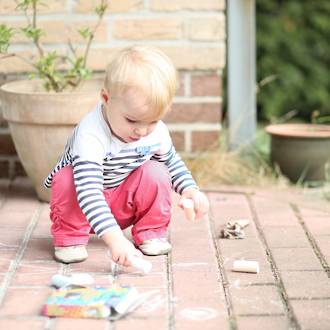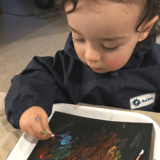Shop
01736
https://www.under5s.co.nz/shop/Hot+Topics+Articles/Toys+Books+Play/Play+ideas/Outdoor+learning+fun+for+under+2s.html
Outdoor learning fun for under 2s
|
Have a go at some of these fun outdoor activities with your baby or toddler to help encourage learning through play.
|
You might also be interested in ...
Benefits of process art for toddlers & preschoolers
Process art is a hugely positive way to foster creativity in toddlers and preschoolers and comes with many benefits. Process art is all about the experience, rather than the final outcome, providing toddlers and preschoolers with the opportunity to be themselves, make their own decisions and to have the freedom to be creative in a way that suits their learning.
15 Fun winter activities
Just because it’s cold and wet outside, doesn’t mean kids can’t have fun during winter. Here are 15 fun winter activities that will keep your toddler and preschooler entertained during the colder months.
join usJoin us on social media for all our latest news. |
sign upSign up and receive our latest newsletters. |
|







Water play ideas
1. Set up a water table
Set up a water table using a low table which a young toddler can stand at and some large bowls of water. This enables water play on less warm days.
For water play consider adding some fun tools – egg beaters, whisks, different sized containers, sieves, sponges, spoons, cups, objects that float and sink and natural materials.
You could also add a few drops of food colouring, so when children are filling and pouring jugs they can see the level changing more clearly.
2. Wash a baby doll
One to two year olds particularly will love to wash a baby doll in a water bath - this is a great first step for role-play.
3. Play with the hose or sprinkler
Gently squirt your child with the hose and let them squirt you back.
This helps to develop a sense of fun. If you have a garden sprinkler this can be great to crawl through or walk through on a hot day.
Benefits of water play
Children under two learn primarily through their senses so water is a perfect medium for this.
Through water play they explore concepts of cause and effect, seeing how their actions have a reaction or how the environment causes a reaction, for example the warm sun drying the water off the deck.
Through play they are developing early science and maths concepts through their own exploration. They see how the metal spoon sinks but the plastic cup floats. They feel the jug get heavy as it fills with water.
Kids can enjoy water play throughout the whole year, but warm weather will make play more comfortable for longer periods of time.
Physical play ideas
1. Outside crawling
The sensation of crawling on the grass is very different from wooden floors or carpet.
Different sensations are stimulating for learning and help to prevent children from growing up very sensitive to touch or afraid of getting messy.
2. Climbing a tree
This seems obvious, but how often do we hear people saying “get down from there, you will fall”?
For a toddler even a small safe tree will give them a great sense of satisfaction.
Be close enough to offer assistance if needed, but let them try and climb to the lower branches.
3. Chalk families
Lay your toddler down on the concrete and draw around their body with a chalk outline.
Choose chunky styled chalk so they can hold it and have a turn too.
Draw other family members as this helps them to learn about size, shape and their own self-awareness.
4. Hang toys from tree branches
For example, string up some instruments to find and play with, or listen to, as they swing in the wind.
They will then have to reach up to play and all their little fingers are developed as they explore the hanging toys.
It’s good for eye health too as they focus on moving objects in the wind.
Safety note: remove the instruments once they're finished and supervise throughout so choking or entanglement is not a hazard.
5. Big 3D buildings
Have boxes like shoe boxes and large furniture boxes to construct with, climb in and out of and to draw on.
This makes large muscles strong and develops balance. It also develops creativity with using objects for different purposes.
6. Messy play
Make some slime or finger paint. Get your hands in their too as your child will follow your lead.
You will be surprised how therapeutic this can be.
7. Ice play
Fill containers with plain water or with a few drops of food colouring. Then add leaves or flowers, or plastic toys before freezing.
You can also fill balloons with water and then cut off the balloon once frozen to make ice balls. Tip onto the deck or into a paddling pool or perhaps a low outdoor table.
Ice play teaches early science with water turning to a solid and then back to a liquid again. This is great for the senses and for dexterity in little hands.
8. Bubbles
Have a go at making your own bubble mixture.
As well as your hands to pop bubbles, try using a new clean plastic fly swat to chase and pop the bubbles.
Bubbles help to develop depth perception and timing.
9. Gardening
If you like to garden, have a large pot or small planter box for your child and their own child sized garden tools.
Here the process is what is important. Don’t expect any flowers to survive their enthusiastic digging. The enjoyment is the dirt and the digging with both tools and hands.
If you don’t have a garden, many communities now have their own gardens for locals to participate in - contact your local community centre or local council to find out if there is one near you.
Gardening helps children get to learn about the natural environment around them including where their food comes from.
10. Grass clippings
Try with a small amount and if there are no allergies gather up a container of grass clippings to use in a similar way to sand play.
This provides an interesting sensory experience and develops grasping and overall hand development.
11. Have a picnic in your own backyard
Children love these little surprises from the usual day-today routines. It’s simple, easy and fun.
Take out a blanket and your lunch or morning or afternoon teal in a chilly bin or picnic basket.
Children learn to enjoy change and spontaneity. It's fantastic for fussy eaters as it makes a relaxed mealtime where the focus isn’t on the food.
12. Set up a reading area
Set up a reading area in the shade with a blanket, pillows and their favourite books.
For non-mobile babies lying with the breeze and some gentle morning sun on them is a lovely sensory experience. They can watch the clouds move and the birds in the trees.
When thinking about experiences for infants we often need to look through their eyes. What we have seen hundreds of times may be a first for them.
First rainbow after a sun shower or watching the sun cast shadows from the trees may be interesting and new to your baby.
This experience provides a balance of busy and quiet play. Time to stop and smell the roses, perhaps literally!
13. Play out in the rain
During summer the weather is warmer but we will still have some rainy days.
Get your kids to put their gumboots on and jump around in puddles.
Children develop a sense of fun while trying out challenging jumping skills.
Safety note
Under two year olds need constant supervision with all play but especially water play. Tip out all water before going inside as shallow water is still a risk.More kids activity articles to enjoy:
Source: This article has been written by Creators, a nationwide service offering quality home-based care and education. Creators are passionate about seeing every child’s unique talent being recognized and nurtured.